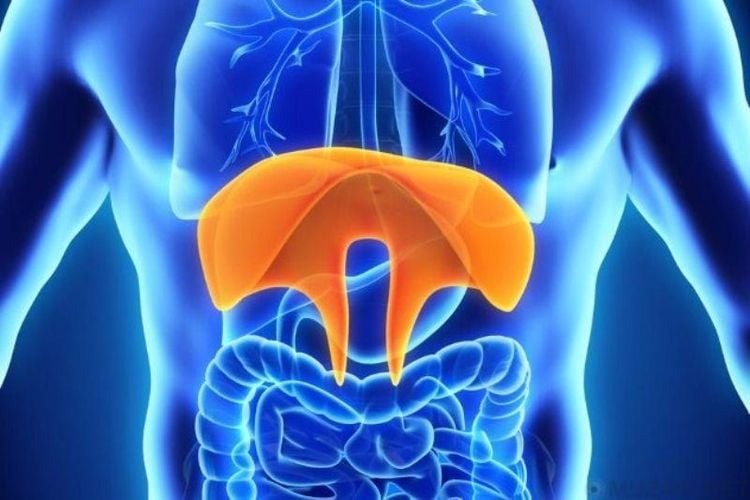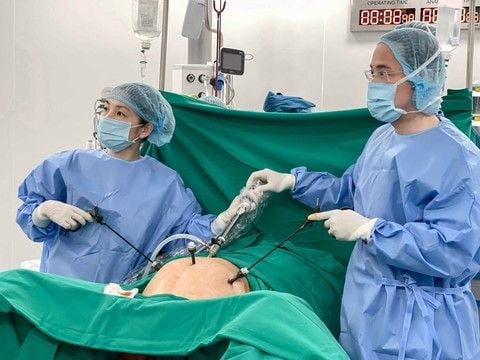The diaphragm is an important organ in the respiratory system. When there is diaphragmatic dysfunction, it can cause shortness of breath and hiccups.
1. Where is the diaphragm? What is its function?
The diaphragm is a flat, broad, dome-shaped striated muscle forming a fibromuscular partition between the thoracic and abdominal cavity. The diaphragm plays an important role in the physiology of the respiratory system. When the diaphragm contracts, its dome lowers, allowing the chest cavity to expand, reducing intrathoracic pressure, and enabling air to be drawn into the lungs, and vice versa.
Anatomically, the diaphragm has an average surface area of about 250 cm². When the diaphragm lowers by 1 cm, the air volume entering the lungs increases by approximately 250 ml, about half of the tidal volume. When the diaphragm lowers by 7–8 cm, the air volume in the lungs can reach up to 2000 ml. Therefore, any damage to the diaphragm significantly affects the airflow into and out of the lungs, leading to respiratory failure.
2. How dangerous is diaphragmatic dysfunction?

The symptoms of diaphragmatic dysfunction vary in severity, depending on the extent of the damage. If the diaphragm is only weakened but not paralyzed, or if the damage occurs only on one side (either the right or left diaphragm), the patient may only experience shortness of breath during exertion or strenuous activities.
In cases where the diaphragm is completely paralyzed, symptoms of shortness of breath will be more persistent. Paralysis of one side of the diaphragm can also cause difficulty breathing when the patient lies on their back. Additionally, underlying conditions such as heart failure, chronic obstructive pulmonary disease (COPD), obesity, and myasthenia gravis can worsen shortness of breath when diaphragmatic dysfunction occurs.
Shortness of breath due to bilateral diaphragmatic paralysis worsens when the patient bends forward, lies flat, or immerses their body in water above the waist. Complete diaphragmatic paralysis often results in insomnia, reduced ventilation during sleep, fatigue, poor concentration, headaches, and dizziness. Other complications of diaphragmatic paralysis include lung collapse or inflammation at the lung bases.
3. What causes diaphragmatic dysfunction?
There are many causes of diaphragmatic dysfunction. Based on the location of the damage, it is classified into two main types: brain and spinal cord injuries, such as multiple sclerosis.
Other causes include stroke, Arnold-Chiari malformation, quadriplegia, amyotrophic lateral sclerosis (ALS), polio, and muscle atrophy. Damage to the phrenic nerve can occur in Guillain-Barré syndrome, mediastinal tumors, peripheral neuropathy, chronic inflammatory demyelinating neuropathies, or as a complication of cardiac surgery. Some cases are idiopathic (of unknown cause).
Additionally, excessive lung hyperinflation seen in conditions such as COPD and asthma can also contribute to diaphragmatic dysfunction.
Diaphragmatic damage can also be associated with conditions such as myasthenia gravis, drug toxicity, muscular dystrophy, infectious or metabolic myositis, and prolonged corticosteroid use. Diaphragmatic dysfunction is also common in critically ill patients in intensive care units, especially those with infections, multiple organ failure, prolonged mechanical ventilation, diabetes, severe malnutrition, muscle relaxant use, or electrolyte imbalances such as low potassium, phosphate, calcium, or magnesium levels.

4. Treatment of diaphragmatic dysfunction
The treatment of diaphragmatic dysfunction primarily focuses on addressing the underlying cause, such as brain and spinal cord diseases, replenishing potassium, phosphate, magnesium, and calcium levels, managing lung hyperinflation seen in COPD and asthma, and treating infections.
If shortness of breath worsens, the patient may require intermittent or continuous mechanical ventilation. In severe cases where medical treatment fails, surgical intervention such as diaphragmatic plication (tightening the diaphragm) may be indicated.
Vinmec International Hospital ensures high medical expertise with a team of experienced doctors and modern technological equipment. It is also distinguished by its comprehensive, professional medical consultation and treatment services, as well as a clean, safe, and highly sterile healthcare environment.
Please dial HOTLINE for more information or register for an appointment HERE. Download MyVinmec app to make appointments faster and to manage your bookings easily.
To arrange an appointment, please call HOTLINE or make your reservation directly HERE. You may also download the MyVinmec app to schedule appointments faster and manage your reservations more conveniently.








